Egypt
- Amarna, Spring Season 2014, Second Report From Barry Kemp
We are now nearing the end of the 2014 spring season. The fieldwork has been concentrated at the Great Aten Temple. Several excavating teams, under the supervision of Miriam Bertram, Delphine Driaux, Anna Hodgkinson and Sue Kelly, assisted by Juan...
- Amarna 2013 Begins
2013 STARTUP It has proved possible to resume fieldwork at Amarna. Barry Kemp and a small team traveled to the expedition house on Wednesday, January 30th and began work on site on Saturday, February 2nd, with 20 local workmen, mostly from El-Till and...
- Autumn Field School At Amarna
The latest news update from Professor Barry Kemp, from the Amarna Project. On October 14th the current Amarna field school began to assemble, five overseas students and seven SCA inspectors (drawn mostly from the Middle Egypt region) converging on the...
- A Report On Work Recently Completed At Amarna, Spring 2012
By Barry Kemp A REPORT ON WORK RECENTLY COMPLETED AT AMARNA, SPRING 2012 Figure 1 (see captions at end of article)On the last day of March we resumed our fieldwork. The chosen place was the site of the Great Aten Temple, that lies immediately beside...
- Amarna Field School And News
www.amarnatrust.com and www.amarnaproject.com Update by Barry Kemp, 4 March 2012: FIELD SCHOOL As a follow-on from last year's Amarna field school, we are holding another this year, between October 14th and November 22nd (five weeks). Again it will...
Egypt
Work at Amarna in March 2013
With thanks to Barry Kemp and Anna Stevens for the latest Amarna update. Apologies that the images at then end are not in the right order but you will find that the figure numbers correspond to the captions.
Picture captions:
01. Waiting to be given shape again: the foundations of the Great Aten Temple recede eastwards, as far as the extension to the modern cemetery.
Photo by G. Owen (shortly before the completion of the stone walls in the foreground).
02. The stone building that lay behind the northern brick pylon, its walls and column locations recreated in stone and cement. Photo, looking to the north, by G. Owen (shortly before the completion of the stone walls).
03. Final cleaning of the tops of the newly laid stone blocks, the brick pylon and wide entrance ramp in the foreground. View to the north-east.
04. Final view of the stone building, after the last blocks had been laid.
View to the north, by G. Owen. 05. Detail of the entrance to the stone building, after the last blocks had been laid. View to the south-west, by G. Owen.
06. The two sets of gypsum-lined troughs surrounding a rectangular pedestal of mud. The pair in the foreground belong to the final phase of the temple; the pair in the background belong to an earlier layout that was subsequently buried. View to the south, by G. Owen.
07. Carved stone fragment S-8207, representing the clothing of a human figure in a scene carved in indurated limestone. Photo by G. Owen.
08. Carved stone fragment S-7863, part of an insert made from indurated limestone and intended as a patch for an area of damage in the original blocks.
The first part of the 2013 season ended on Wednesday, March 27th, with the formal return of the site to the SCA inspectorate. The March results mainly reinforced the observations made in the February report, and should be visible from the accompanying photographs.
On the very last day, our team of builders put the finishing touches to the outlines of the small stone palace that had stood there in Akhenaten's time, on its distinctive gypsum foundation platform. They had responded well to the challenge of laying larger and more carefully cut limestone blocks. The result displays the plan of the building in a simple way.
By this time also, the large Pendlebury dump over the northern pylon and ground outside had completely gone, fully exposing the brickwork of the pylon. This now needs to be repaired and built up with new bricks to a slightly greater height. Beside it, on the south, comes the outer temple ramp, of brick retaining walls and sand fill, 9.15 m wide.
Already we have the makings of a viewing platform, easily accessible from the asphalt road. What might be the view in a few years' time? The viewing area will run for twice the present length, to include the southern pylon as well, so that the access ramp stands in the centre. Beyond comes a broad flat surface of compacted mud that runs up to the monumental front to the stone temple, 30 m behind the brick pylons. The recently completed outline of the small limestone palace faces on to this on the left.
This open space had brought people in - members of the public? - to perform offering-ceremonies on the mud bases surrounded by gypsum-lined troughs, a practice that had begun when the temple site was first laid out.
Unfortunately, these are too fragile to leave exposed but it should be possible to devise a way of marking their locations. They seem to represent regular participation in a more modest style of worship, separate from the grand setting created by the stone architecture. The small stone palace, if such it really is, belongs within this zone and seems to lack the kind of separation of the king from modest cult surroundings that one might have expected.
The monumental front to the stone temple comprised a pair of pylons made from limestone blocks, fronted on either side of the wide entrance path by a deep colonnade composed of two rows of four gigantic columns. Their size and design were similar to those at the Small Aten Temple. The current plan is to rebuild the pylon foundations to a height of two courses of stone blocks above the ground level, and to mark the positions of the columns with circular pads of white cement, 3 m across. Behind the stone pylons the visitor will then see the progression of open courts, defined by fresh stonework, but only to the height of one or two courses, and filled with the ranks of stone offering tables that define the unique character of Akhenaten's cult of the Aten.
An interesting question arises here: how tall were the offering tables? The tomb pictures show them standing to around waist height. This year's re-excavation of the area of the temple axis, as it had stood in the very first phase of use, brought to light two rectangles of limestone blocks that remained undamaged (they are visible in pictures 01 and 02). They might be supports for pieces of sculpture, although they held no trace of mortar to anchor something like that. Or they could be offering-tables (perhaps originally covered with a large mat, which would explain the rough surface). What is to be noted is that they were made to lie at the same level as the surrounding ground. Might this have applied to the main mass of stone offering-tables, that they were more or less at ground level? It might have made them easier of access.
We all know that, after Amarna had finished, the original building blocks - tens of thousands of them - were methodically removed for re-use at other construction sites. Many fragments broke off during demolition, and these provide clues to the original decorative schemes. We collect them, often from Pendlebury's dumps, and from them a sketchy outline is starting to appear of the appearance of the temple front. It is summarised by Kristin Thompson in her season's report:
"The fragments of hard stone being generated by the current excavations make it vividly clear that the front of the Great Aten Temple was decorated in a colorful and lavish fashion using many varieties of beautiful hard stones. Though the destruction of the temple was thorough, and many of the pieces that have come to light are small and difficult to interpret, some yield important clues that permit us to guess at the decoration of this crucial building."
Some of these hard stone pieces are not from blocks. They are fragments of inserts (rather than inlays), laboriously worked to fit into a gap in backing stonework where damage had occurred or there was a flaw in the stone. The practice is visible still at Amarna at some of the Boundary Stelae, for example. Some of the inserts, and some of the fragments broken from the main surfaces, imply that areas of the temple were made from hard stones - especially the marble-like indurated limestone - and were decorated with scenes in addition to the usual range of Aten formulae. Such hard stone blocks might have been much larger than the modest, standardized size of the common limestone blocks.
The work at the front of the Great Aten Temple is only the first part of the 2013 schedule of work. On March 29th, the excavating team for the South Tombs Cemetery, of nine archaeologists led by Anna Stevens, arrived at the expedition house for a month's work, that will be accompanied by continuation of the conservation of the wooden coffins that are such important discoveries.
It remains, once again, to offer wholehearted thanks our supporters, who make the work at Amarna possible.
7 April 2013
Barry Kemp/Anna Stevens
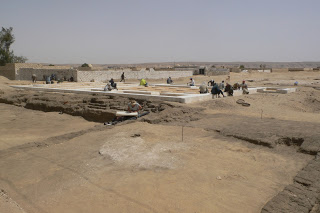 |
| Figure 3 |
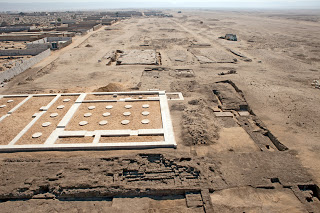 |
| Figure 1 |
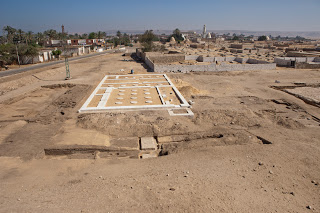 |
| Figure 2 |
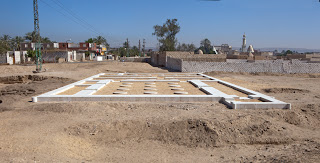 |
| Figure 4 |
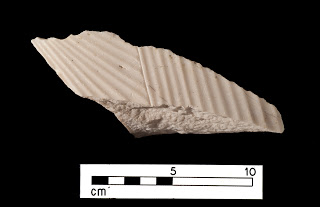 |
| Figure 7 |
 |
| Figure 6 |
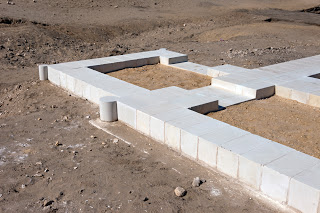 |
| Figure 5 |
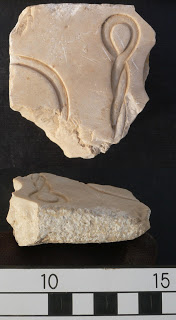 |
| Figure 8 |
Picture captions:
01. Waiting to be given shape again: the foundations of the Great Aten Temple recede eastwards, as far as the extension to the modern cemetery.
Photo by G. Owen (shortly before the completion of the stone walls in the foreground).
02. The stone building that lay behind the northern brick pylon, its walls and column locations recreated in stone and cement. Photo, looking to the north, by G. Owen (shortly before the completion of the stone walls).
03. Final cleaning of the tops of the newly laid stone blocks, the brick pylon and wide entrance ramp in the foreground. View to the north-east.
04. Final view of the stone building, after the last blocks had been laid.
View to the north, by G. Owen. 05. Detail of the entrance to the stone building, after the last blocks had been laid. View to the south-west, by G. Owen.
06. The two sets of gypsum-lined troughs surrounding a rectangular pedestal of mud. The pair in the foreground belong to the final phase of the temple; the pair in the background belong to an earlier layout that was subsequently buried. View to the south, by G. Owen.
07. Carved stone fragment S-8207, representing the clothing of a human figure in a scene carved in indurated limestone. Photo by G. Owen.
08. Carved stone fragment S-7863, part of an insert made from indurated limestone and intended as a patch for an area of damage in the original blocks.
- Amarna, Spring Season 2014, Second Report From Barry Kemp
We are now nearing the end of the 2014 spring season. The fieldwork has been concentrated at the Great Aten Temple. Several excavating teams, under the supervision of Miriam Bertram, Delphine Driaux, Anna Hodgkinson and Sue Kelly, assisted by Juan...
- Amarna 2013 Begins
2013 STARTUP It has proved possible to resume fieldwork at Amarna. Barry Kemp and a small team traveled to the expedition house on Wednesday, January 30th and began work on site on Saturday, February 2nd, with 20 local workmen, mostly from El-Till and...
- Autumn Field School At Amarna
The latest news update from Professor Barry Kemp, from the Amarna Project. On October 14th the current Amarna field school began to assemble, five overseas students and seven SCA inspectors (drawn mostly from the Middle Egypt region) converging on the...
- A Report On Work Recently Completed At Amarna, Spring 2012
By Barry Kemp A REPORT ON WORK RECENTLY COMPLETED AT AMARNA, SPRING 2012 Figure 1 (see captions at end of article)On the last day of March we resumed our fieldwork. The chosen place was the site of the Great Aten Temple, that lies immediately beside...
- Amarna Field School And News
www.amarnatrust.com and www.amarnaproject.com Update by Barry Kemp, 4 March 2012: FIELD SCHOOL As a follow-on from last year's Amarna field school, we are holding another this year, between October 14th and November 22nd (five weeks). Again it will...
